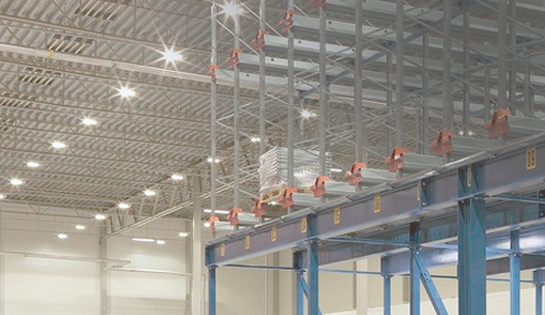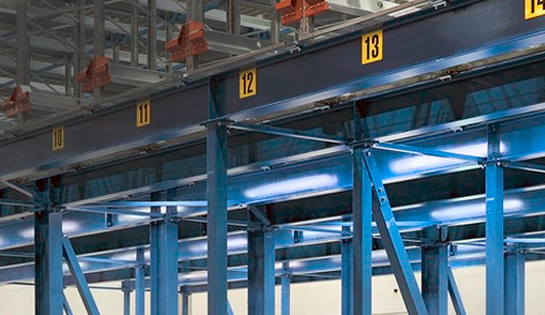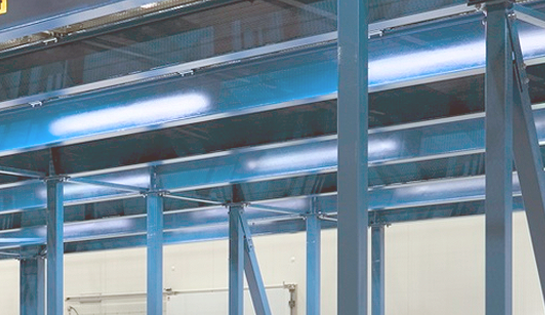Pallet Rack Configuration Tips for Warehouse Managers
-

Pallet Rack Configuration Tips for Warehouse Managers
According to the United States Bureau of Labor Statistics, one in 20 warehouse workers is injured every year. Being knowledgable and proactive are two of your greatest defenses against workplace injuries. Here, we'll provide an in-depth guide to pallet rack safety and other resources for managers so you can implement best practices for keeping workers safe.
Offer Training & Certifications
Before any employee is permitted to work in the warehouse, near the pallet racking systems, or behind the controls of a forklift, they need to receive proper training.
All employees should be trained in the proper use of warehouse equipment, including machinery and racking systems. The most efficient racking systems have moving parts. They need to be loaded and unloaded using the right technique.
Anyone operating a forklift should receive adequate training, as well. According to OSHA, there are nearly 35,000 forklift-related injuries each year, with 85 accidents resulting in death.
Only those employees with proper training and certifications should be allowed on the warehouse floor.
But training isn't just for employees. There are plenty of resources available for managers too.
Using the latest software, managers can monitor both machinery and operators. Features include:
- Recording equipment and product damage
- Monitoring forklift battery life and maintenance needs
- Manage forklift operator certifications
- Promote operator accountability
- Meet compliance requirements
Other resources include labor management and asset management. By staying up-to-date on the daily operations of your warehouse, you can make smart decisions that boost efficiency and safety.
Common Pallet Rack Safety Concerns
Being aware of common pallet rack safety concerns can help prevent accidents and serious injury. Here are a few of the most common pallet rack safety tips to help reduce the risk of injury on the job.
Obey Weight Capacity
This is a rule people often overlook or disregard. The weight capacity of your pallet racking system isn't just a suggestion – it's a guideline that you need to follow. Overloading a pallet rack is a recipe for disaster.
All weight capacities for both uprights and beams should be visible on your racks. Do not exceed these limits even by a few pounds. These few pounds add up and could lead to serious injury, damaged equipment, and ruined inventory.
Install Upright Racks on Level Ground
Anytime you're building something up vertically, it needs to be done on a level, sturdy ground.
Even a smooth, seemingly flat cement floor may not be level. Be sure that all uprights are plumb and square before beginning installation.
Shim plates, also known as pallet rack shims, can help. These plates go under the footplates of the uprights to create a sturdy base. Shim plates prevent the uprights from shifting or wobbling.
It's also essential that the pallet rack system is square. This guarantees weight is distributed evenly and supports the system's overall strength.
Load Racks Evenly
Similar to never exceeding the recommended weight capacity on your racking system, you never want to load pallets unevenly.
Make sure that all loads are placed squarely on the rack and rest evenly across the beams to properly disperse the weight.
Whenever possible, place an even number of pallets on each shelf. Aside from exceeding the weight capacity, uneven pallet placement puts machine operators at risk.
Employees need ample room to move around both vertically and horizontally. Always enough space so that operators can safely load and unload inventory.
Repair Damaged Racks Immediately
The best way to identify and address necessary repairs is to perform routine checks and maintenance on all warehouse equipment. Inspect all racks, beams, and uprights to check they are secure and free of damage.
Avoid using any pallet rack system in need of repair. Even one damaged beam is enough to put workers at risk. Similar to a stack of cards, a single beam in a tall structure compromises its stability and efficiency.
Whenever possible, perform repairs to racks, equipment, and machinery immediately. A software system that monitors forklift maintenance and efficiency can help you identify issues before they become a safety hazard.
Protect Uprights from Collision
Collisions in a warehouse or storage facility are more common than you may realize. New forklift operators, distracted workers, or overloaded forklifts can all cause a machine to collide with a pallet rack upright.
One way to protect your uprights is to add a protective cover or column protector. Although this won't stop all damage, it can help take the brunt of the force from machinery. It may also reduce wear and tear.
Protect all uprights in high-traffic areas. End-of-aisle guards help protect racks from reversing and turning equipment.
If lighting is an issue in your warehouse, add light reflectors, reflective tape, and floor markers to help forklift operators stay the course.
Prevent Pallets from Falling off the Back of the Rack
Some pallet rack systems have open backs where pallets are loaded and unloaded. It's important that all forklift operators and employees know how to properly handle inventory without letting products fall off the back of the rack.
Installing a rack barrier can help prevent this type of accident. Netting or heavy-duty wire are great options for keeping pallets off the floor and catching loose debris.
Backstop beams are another option and prevent skids from being pushed off the back of the racking system
Pallet Rack Inverstment
Pallet rack safety protects not only your employees but also your reputation and your bottom line.
Safe, happy workers are more productive. A staff that is properly trained is less likely to cause accidents, injuries, or damage to inventory.
Practicing a few of these pallet rack safety tips is just the beginning. Regular maintenance of racks and machinery, monitoring equipment use and performing observations help provide long-term safety and efficiency.
Contact our team of professionals for more information and help with all your warehouse needs.




